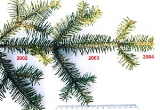
Evergreen
Overview
Botany
Botany, plant science, or plant biology is a branch of biology that involves the scientific study of plant life. Traditionally, botany also included the study of fungi, algae and viruses...
, an evergreen plant is a plant that has leaves
Leaf
A leaf is an organ of a vascular plant, as defined in botanical terms, and in particular in plant morphology. Foliage is a mass noun that refers to leaves as a feature of plants....
in all seasons. This contrasts with deciduous
Deciduous
Deciduous means "falling off at maturity" or "tending to fall off", and is typically used in reference to trees or shrubs that lose their leaves seasonally, and to the shedding of other plant structures such as petals after flowering or fruit when ripe...
plants, which completely lose their foliage during the winter or dry season.
There are many different kinds of evergreen plants, both trees and shrubs. Evergreens include:
- most species of conifersPinophytaThe conifers, division Pinophyta, also known as division Coniferophyta or Coniferae, are one of 13 or 14 division level taxa within the Kingdom Plantae. Pinophytes are gymnosperms. They are cone-bearing seed plants with vascular tissue; all extant conifers are woody plants, the great majority being...
(e.g., hemlockTsugaTsuga is a genus of conifers in the family Pinaceae. The common name hemlock is derived from a perceived similarity in the smell of its crushed foliage to that of the unrelated plant poison hemlock....
, blue spruceBlue SprucePicea pungens is a species of spruce native to western North America, from southeast Idaho and southwest Wyoming, south through Utah and Colorado to Arizona and New Mexico. It grows at high altitudes from altitude, though unlike Engelmann Spruce in the same area, it does not reach the alpine...
, red cedarThuja plicataThuja plicata, commonly called Western or pacific red cedar, giant or western arborvitae, giant cedar, or shinglewood, is a species of Thuja, an evergreen coniferous tree in the cypress family Cupressaceae native to western North America...
, and whitePinus classificationThere are three main subgenera of Pinus, the subgenus Strobus , the subgenus Ducampopinus , and the subgenus Pinus...
/scotsScots PinePinus sylvestris, commonly known as the Scots Pine, is a species of pine native to Europe and Asia, ranging from Scotland, Ireland and Portugal in the west, east to eastern Siberia, south to the Caucasus Mountains, and as far north as well inside the Arctic Circle in Scandinavia...
/jack pineJack PineJack pine is a North American pine with its native range in Canada east of the Rocky Mountains from Northwest Territories to Nova Scotia, and the northeast of the United States from Minnesota to Maine, with the southernmost part of the range just into northwest Indiana...
)
- live oakLive oakLive oak , also known as the southern live oak, is a normally evergreen oak tree native to the southeastern United States...
, hollyHollyIlex) is a genus of 400 to 600 species of flowering plants in the family Aquifoliaceae, and the only living genus in that family. The species are evergreen and deciduous trees, shrubs, and climbers from tropics to temperate zones world wide....
, and "ancient" gymnospermGymnospermThe gymnosperms are a group of seed-bearing plants that includes conifers, cycads, Ginkgo, and Gnetales. The term "gymnosperm" comes from the Greek word gymnospermos , meaning "naked seeds", after the unenclosed condition of their seeds...
s such as cycadCycadCycads are seed plants typically characterized by a stout and woody trunk with a crown of large, hard and stiff, evergreen leaves. They usually have pinnate leaves. The individual plants are either all male or all female . Cycads vary in size from having a trunk that is only a few centimeters...
s
- most angiosperms from frost-free climates, such as eucalyptEucalyptEucalypts are woody plants belonging to three closely related genera:Eucalyptus, Corymbia and Angophora.In 1995 new evidence, largely genetic, indicated that some prominent Eucalyptus species were actually more closely related to Angophora than to the other eucalypts; they were split off into the...
s and rainforestRainforestRainforests are forests characterized by high rainfall, with definitions based on a minimum normal annual rainfall of 1750-2000 mm...
trees
An additional special case exists in Welwitschia
Welwitschia
Welwitschia is a monotypic genus of gymnosperm plant, composed solely of the very distinct Welwitschia mirabilis. The plant is commonly simply known as Welwitschia in English. It is known locally as !kharos or khurub , tweeblaarkanniedood , nyanka , or onyanga , among others...
, an African gymnosperm
Gymnosperm
The gymnosperms are a group of seed-bearing plants that includes conifers, cycads, Ginkgo, and Gnetales. The term "gymnosperm" comes from the Greek word gymnospermos , meaning "naked seeds", after the unenclosed condition of their seeds...
plant that produces only two leaves, which grow continuously throughout the plant's life but gradually wear away at the apex, giving 20–40 years' persistence of leaf tissue
Tissue (biology)
Tissue is a cellular organizational level intermediate between cells and a complete organism. A tissue is an ensemble of cells, not necessarily identical, but from the same origin, that together carry out a specific function. These are called tissues because of their identical functioning...
.
Leaf persistence in evergreen plants varies from a few months (with new leaves constantly being grown as old ones are shed) to several decades (over thirty years in the Great Basin Bristlecone Pine).
Deciduous trees shed their leaves usually as an adaptation to a cold or dry season.

